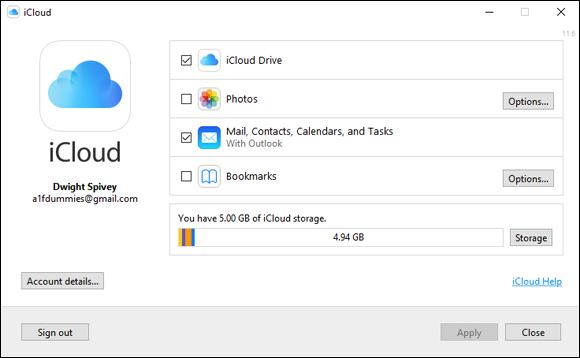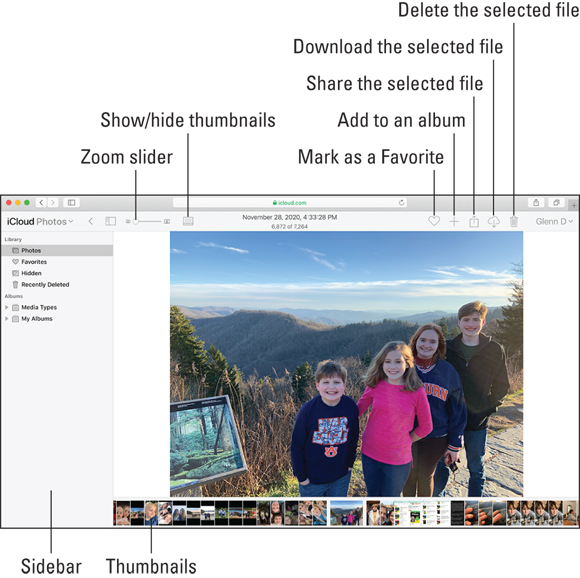Chapter 10
Picture This!
IN THIS CHAPTER
![]() Accessing and enabling Photos on your devices
Accessing and enabling Photos on your devices
![]() Uploading, downloading, and sharing photos and videos
Uploading, downloading, and sharing photos and videos
Photos and videos are ubiquitous these days. Everyone seems to have a smartphone and they use it to take photos and videos of everything from the most important life events to the silliest selfies they can conjure. (I’ll be quite pleased when the dreaded “duck face” pose has ended its reign on social media.) The cameras on these things are amazing, allowing budding photogs to take pictures that would rival those taken with the very best photographic equipment from a decade or two ago.
However, the age-old problem of organization still exists. In the good ole days, photos were kept in albums or, worse, just tossed into boxes that were opened once in a blue moon. The digital age has ushered in another problem: The pictures you want are on a different device than the one you have handy. For goodness’ sake, all we want is for our photos and videos to appear on every single device we own! Can anyone help us realize this goal?
“Why, yes,” says Apple, “we can.” iCloud Photos is just what the doctor ordered.
iCloud Photos stores your photos and videos in iCloud and enables you to sync them across your Apple devices and even Windows PCs.
Enable and Access iCloud Photos
In this section, you find out how to enable, access, and synchronize iCloud Photos on your devices. Something to remember: You’ll need to be signed into your Apple ID on whatever devices you want to sync notes with: your iPhone, iPad, Mac, or Windows PC (using the iCloud for Windows app).
iCloud.com
All Apple One subscribers can access their photos and videos with the iCloud.com website’s Photos app:
- Open a web browser and go to
www.icloud.com. - Enter your Apple ID and password when prompted.
- Click the Photos button to launch the web version of Photos.
Apple devices
To sync photos and videos with your Apple devices, you must ensure that iCloud Photos is enabled on them. To enable syncing and to open the Photos app on your iPhone or iPad:
- Open the Settings app.
- Tap your Apple ID at the top of the Settings list.
- Tap iCloud and then tap Photos.
- Tap the iCloud Photos switch to enable it (if it’s not already enabled).
Leave the Settings app.
If your iPhone or iPad uses Face ID, swipe up to leave the app. If your iPhone or iPad has a Home button, press it to leave Settings.
- Tap to open the Photos app.
To enable and access iCloud Photos on your Mac:
- Click
 in the top-left corner of your screen and select System Preferences.
in the top-left corner of your screen and select System Preferences. - Select Apple ID.
- Select the box next to Photos to enable it, if it’s not already selected.
- Open your Applications folder, and double-click the Photos app icon to open it.
Windows-based PC
You’ll need the iCloud Drive app, which is available for Windows 10 by downloading it from the Microsoft Store. For more information, visit the “Download iCloud for Windows” article on Apple’s Support site at https://support.apple.com/en-us/HT204283.
After you’ve downloaded the iCloud for Windows app, do the following:
- Open the app.
- Enter your Apple ID and password in the appropriate fields.
- Click the Sign In button in the lower-right of the window.
- Make sure the check box next to Photos is selected, and then click the Options button (shown in Figure 10-1).
- Select iCloud Photos, click Done, and then click the Apply button in the lower right.

FIGURE 10-1: Set up iCloud Photos using the iCloud for Windows app.
Working with iCloud Photos
Let’s take a look at how to navigate the Photos app in its various forms. Photos in iCloud.com is simple but powerful. The Photos app for iOS behaves a bit differently than its cousins for macOS and iPadOS, so I’ve lumped the latter two together for our purposes in this part of the chapter.
iCloud.com
Photos for iCloud is easy to master but also offers some powerful features (for a web-based app) to help you do more than just dabble. Figure 10-2 shows you the Photos for iCloud interface.
Some options are self-explanatory, but others need a tad bit more info:
- Sidebar: Select an option to view your photos. You can view them all, by album, and by several other options, including Recently Deleted.
- Share the selected file: Click to share the file with others via a web link.

FIGURE 10-2: Photos in iCloud.com is a great web-based app for photos and videos.
- Download the selected file: Click to save a full-resolution copy of the image to your computer.
The iCloud User Guide is chock-full of more information on the web version of Photos. Go to https://support.apple.com/guide/icloud/welcome/icloud and navigate to the Photos section to find out more than I can possibly cover in this chapter.
iOS
The Photos interface is necessarily different than other versions of the app due to the small-screen real estate on an iPhone. Some options and features are found in different locations than in other versions based on what you’re viewing.
Figure 10-3 is the default view when you first open Photos for iOS.

FIGURE 10-3: The main view from the Library tab in Photos for iOS.
Let’s check out some of the options:
- More icon: The options available when you tap the More icon depend on the tab selected at the bottom of the screen and the sort option you’ve chosen.
- Select: Tap to put Photos into selection mode. Then tap photos or videos that you’d like to perform a simultaneous action on, such as selecting a set of photos to share with a friend or to delete in one fell swoop.
- Tabs bar: Tap an icon at the bottom of the screen to choose what you want to view in the Photos app. The Library icon shows all files you've stored on your device or in iCloud. The For You icon displays a tab with files curated based on things like location and people. Albums helps you organize photos and videos according to your liking. Search allows you to find files based on several criteria, such as name, people, places, and more.
Figure 10-4 gives you a different take: viewing a photo.

FIGURE 10-4: Viewing a picture in Photos for iOS.
Some of the options include the following:
- Share the selected file: Tap to share a copy of the photo or video with friends, family, enemies, or anyone else you’d like. You can share via apps such as Messages and Mail. This option also lets you create a slideshow, make duplicates, assign a photo to a contact, and much more.
- Edit selected file: Tap to open the edit window. From here you can make adjustments to color, contrast, and brightness. You can also rotate and crop photos.
The iPhone User Guide has much more information about using the options and features native to the Photos app for iOS. Check it out at https://support.apple.com/guide/iphone/welcome/ios.
macOS and iPadOS
Photos for macOS and iPadOS are similar enough that they can occupy the same space in this section. The iPad’s larger screen allows the app to enjoy a feature layout similar to that of the Mac and (to a lesser extent) the web version of the app in iCloud.com.
Figure 10-5 is your Photos for macOS and iPadOS guide.

FIGURE 10-5: Photos for macOS and iPadOS are similar in layout and options.
Some of these options deserve a bit of further attention:
- See the selected file’s info: When you take a picture or video with your iPhone or iPad, much more information is stored than just the image itself. Some of that info includes the file type, the resolution the photo or video was shot with, the location it was captured, and much more that digital media nerds love to know about.
- Auto-enhance: Click or tap to allow Photos to make automatic adjustments to color, saturation, brightness, and more under-the-hood changes that enhance the look of your media files.
Check out the macOS User Guide at https://support.apple.com/guide/mac-help/welcome/mac to find out more about using Photos for macOS.
iPad afficionados will also want to inspect the iPad Users Guide at https://support.apple.com/guide/ipad/welcome/ipados to delve a bit deeper.
Windows-based PC
The iCloud for Windows app opens the door for your PC to sync photos and videos with iCloud and your Apple devices. There’s much more I’d like you to know about iCloud Photos and Windows, and Apple has everything you need to know on their nifty Support site.
To learn more about how iCloud Photos works with Windows, including where files are saved, take a gander at this article on Apple’s Support site called “Set up and use iCloud Photos on your Windows PC”: https://support.apple.com/en-us/HT205323.
That wraps it up for this chapter. I hope you’ve learned a good deal about iCloud Photos, but it's a deep topic that bears further exploration if you’re so inclined. Check out https://support.apple.com/en-us/HT204570 to find answers to questions you may have and some you haven't thought of yet.

 Linux and Android users can access iCloud Photos only via a web browser through iCloud.com.
Linux and Android users can access iCloud Photos only via a web browser through iCloud.com. Be sure to set up your iCloud account on your Apple devices before you set it up on your PC.
Be sure to set up your iCloud account on your Apple devices before you set it up on your PC.